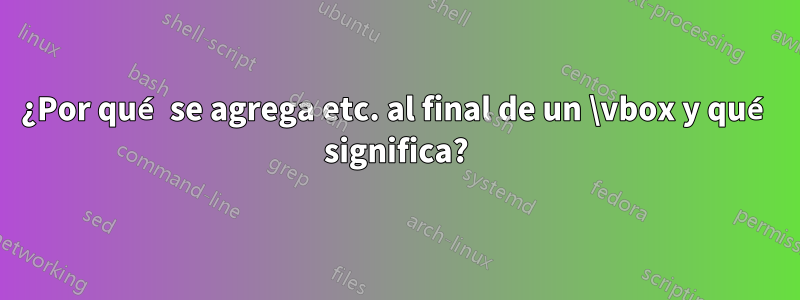
Un breve código de muestra
% pdfTeX
\newbox\thbx
\setbox\thbx\hbox{abc}
\newbox\tvbx
\setbox\tvbx\vbox{\unhbox\thbx}
\showbox\tvbx
\bye
daría salida
\thbx=\box16
\tvbx=\box17
> \box17=
\vbox(6.94444+0.0)x469.75499
.\hbox(6.94444+0.0)x469.75499, glue set 434.47717fil
..\hbox(0.0+0.0)x20.0
..\tenrm a
..\tenrm b
..\kern0.27779
..\tenrm c
..etc.
¿Qué significa la última línea de la salida ( etc.) y por qué TeX la coloca allí?
Respuesta1
De forma predeterminada \showboxbreadth=5, es decir, después de que TeX muestre los primeros cinco elementos de la lista, escribirá etc.para indicar que hay más.
Hay otro parámetro que influye en la salida de \showboxy es \showboxdepth(predeterminado 3), que es el nivel de anidamiento al que desciende TeX. Si se ha excedido la profundidad, esto se indica con [].
Vea también este extracto del TeXbook:
\danger When \TeX\ displays a box as part of diagnostic output, the amount
of data is controlled by two parameters called ^|\showboxbreadth| and
^|\showboxdepth|. The first of these, which plain \TeX\ sets equal to~5,
tells the maximum number of items shown per level; the second, which plain
\TeX\ sets to~3, tells the deepest level. For example, a small box
whose full contents are ^^{internal box format} ^^{symbolic box format}
\begintt
\hbox(4.30554+1.94444)x21.0, glue set 0.5
.\hbox(4.30554+1.94444)x5.0
..\tenrm g
.\glue 5.0 plus 2.0
.\tenrm || (ligature ---)
\endtt
will be abbreviated as follows when |\showboxbreadth=1| and |\showboxdepth=1|:
^^{ligature} ^^{em-dash}
\begintt
\hbox(4.30554+1.94444)x21.0, glue set 0.5
.\hbox(4.30554+1.94444)x5.0 []
.etc.
\endtt
And if you set |\showboxdepth=0|, you get only the top level:
\begintt
\hbox(4.30554+1.94444)x21.0, glue set 0.5 []
\endtt
(Notice how `^|[]|' and `^|etc.|'~indicate that the data has been
truncated.)


